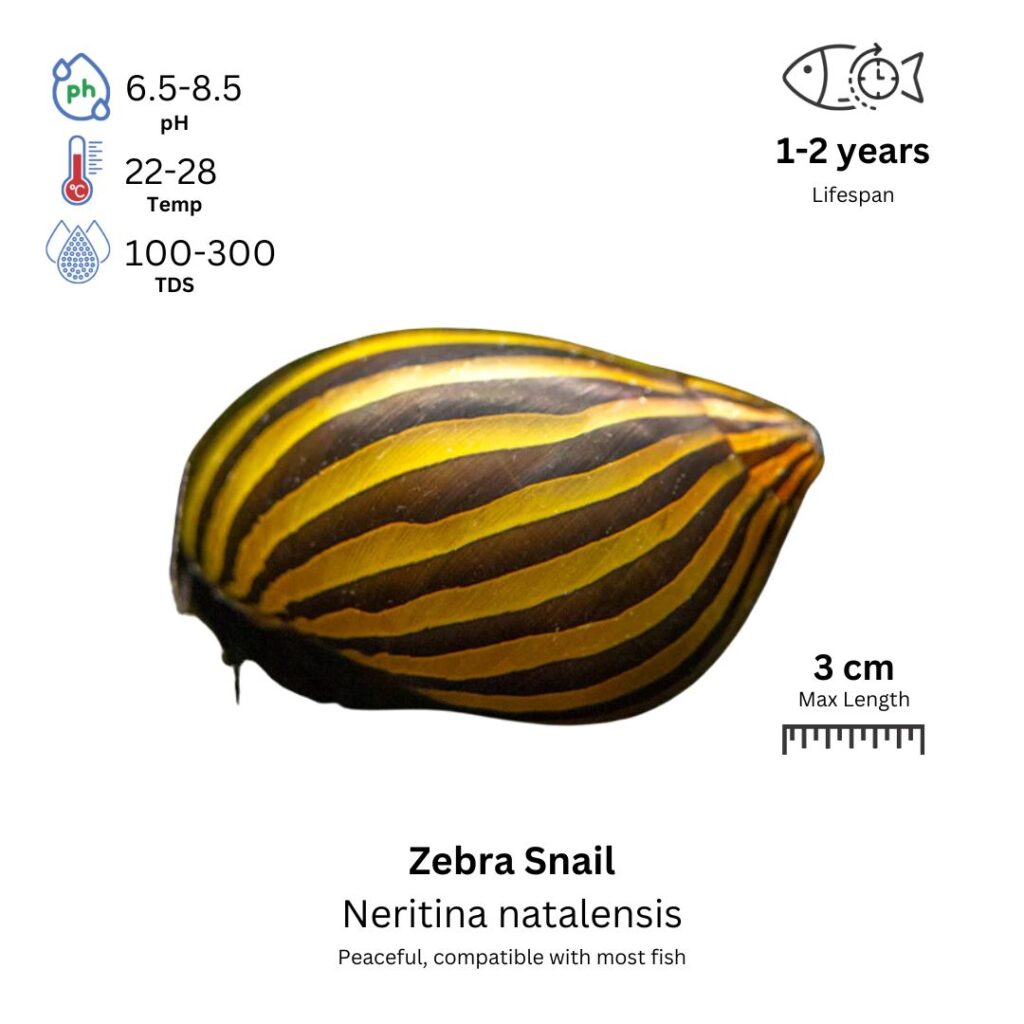Zebra Snail
Neritina natalensis

Description
The Zebra Snail is easily recognized by its striking black and yellow striped shell, resembling the pattern of a zebra. Its body is typically a pale yellow or beige color. These snails are known for their algae-eating habits, often found clinging to rocks or aquarium glass. They are active during the day and often move around the tank, consuming algae and detritus. They are peaceful creatures that rarely cause trouble with other tank inhabitants.
Natural Habitat
Native to freshwater rivers and lakes in Southeast Asia, particularly in regions like Thailand and Malaysia.
Akuarium
Ideal Number in Aquarium: A single snail or a small group of 2-3 for better comfort and activity
Favorite Foods

Primarily algae, but they will also enjoy detritus and leftover food. Supplemental feeding with blanched vegetables (like zucchini) can help keep them well-fed.
Behavior:
Peaceful and non-aggressive. They are generally calm and enjoy grazing on the tank’s surfaces. They do not cause harm to plants or other tankmates.
Special Care:
Zebra Snails require access to calcium for shell growth, so ensuring that the water has sufficient calcium levels is important. Also, ensure that the water is free of copper, as it can be toxic to snails.
Compatibility with Other Fish:
Yes, they are generally compatible with most peaceful freshwater species, including small fish and other snails.
Breeding Tank Setup
While Zebra Snails can breed in community tanks, using a separate breeding tank offers greater control over water quality and allows closer monitoring of egg development. A 10-gallon (38-liter) tank is sufficient for a few individuals, but a 20-gallon (75-liter) setup is better for larger breeding colonies. These snails thrive in slightly alkaline water with a pH of 7.5–8.5, temperatures between 24°C to 28°C, and water hardness levels ranging from 8 to 12 dGH. A sponge filter or gentle internal filter ensures adequate oxygenation without generating strong currents. Fine gravel or sand is suitable as a substrate, and while plants are not essential for breeding, including Java moss or Anubias improves water quality and provides cover. Moderate lighting on a 10–12 hour cycle is sufficient to maintain a stable, healthy environment.
Conditioning the Breeders
While Zebra Snails can breed in community tanks, using a separate breeding tank offers greater control over water quality and allows closer monitoring of egg development. A 10-gallon (38-liter) tank is sufficient for a few individuals, but a 20-gallon (75-liter) setup is better for larger breeding colonies. These snails thrive in slightly alkaline water with a pH of 7.5–8.5, temperatures between 24°C to 28°C, and water hardness levels ranging from 8 to 12 dGH. A sponge filter or gentle internal filter ensures adequate oxygenation without generating strong currents. Fine gravel or sand is suitable as a substrate, and while plants are not essential for breeding, including Java moss or Anubias improves water quality and provides cover. Moderate lighting on a 10–12 hour cycle is sufficient to maintain a stable, healthy environment.
Conditioning the Breeders
To condition Zebra Snails for breeding, ensure they have constant access to algae, their primary food source. Supplement their diet with blanched vegetables such as zucchini, spinach, or lettuce. Calcium-rich additions like cuttlebone, crushed coral, or commercial calcium blocks are important to support shell growth and reproductive health. Weekly water changes of about 25–30% help maintain stable, clean conditions necessary for successful breeding. Consistent water quality and nutrition play a key role in triggering reproductive behavior.
Spawning Behavior
The eggs hatch in approximately 2 to 4 weeks, depending on temperature. As they develop, the eggs darken in color. Upon hatching, the tiny snails drop to the substrate and begin feeding on available biofilm and algae. Ensure sufficient biofilm is present, and supplement with finely crushed algae wafers or soft vegetables. Because the fry are highly sensitive to poor water quality, maintain stable temperature and perform small, frequent water changes. Avoid overfeeding, as decaying food can quickly degrade water quality and harm the juveniles.
Breeding Notes
Zebra Snails reach sexual maturity between 6 to 12 months of age. It is recommended to breed only healthy, mature individuals for optimal offspring viability. Sexing Zebra Snails is difficult, as they exhibit little visual difference; males are often slightly smaller and position themselves behind females during mating. Observation during courtship is often the only reliable method of sex identification. To ensure breeding success, avoid sudden shifts in water conditions, maintain consistent care, and minimize environmental stressors. Proper maintenance and patience are key to successful Zebra Snail reproduction.
